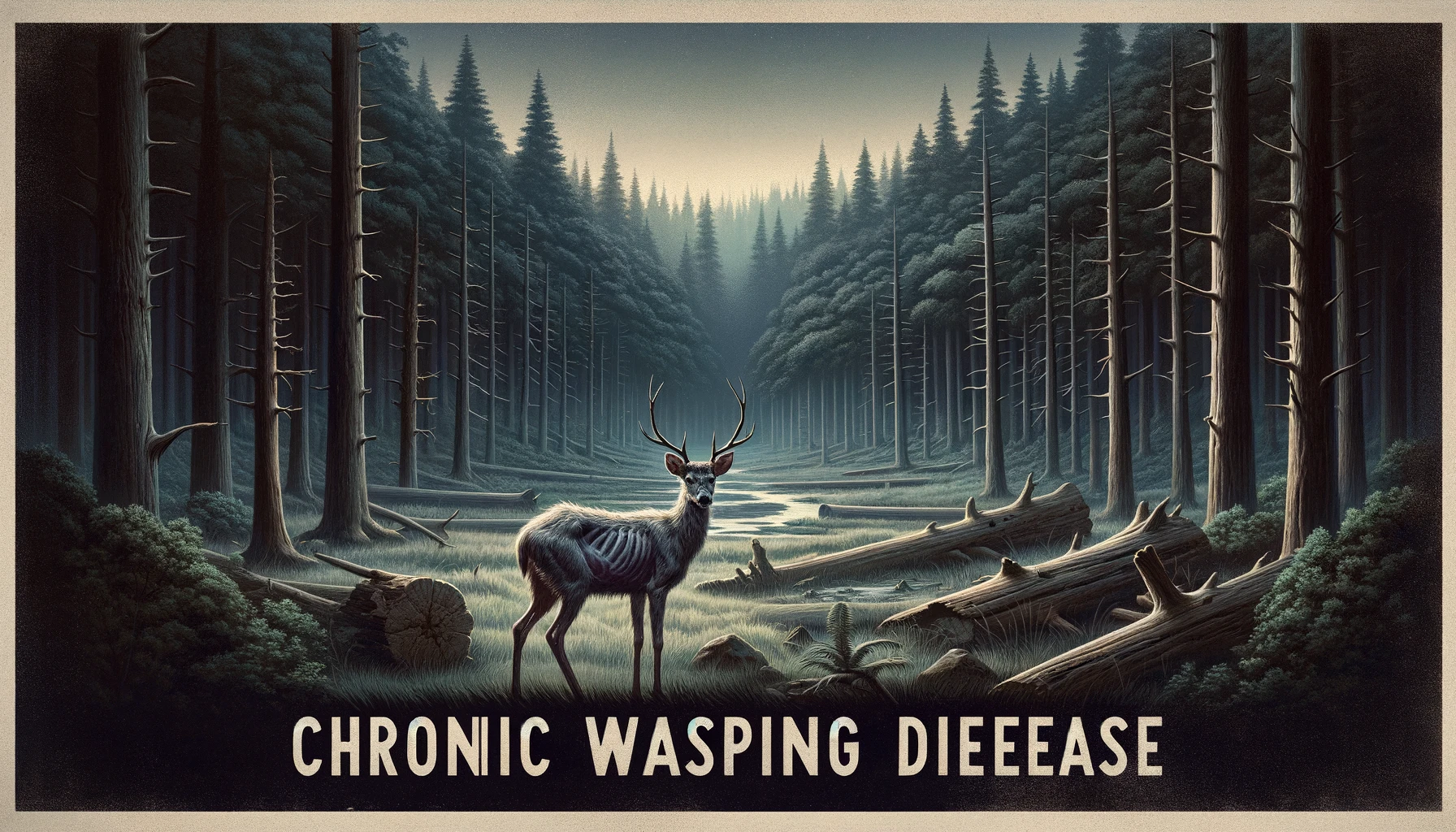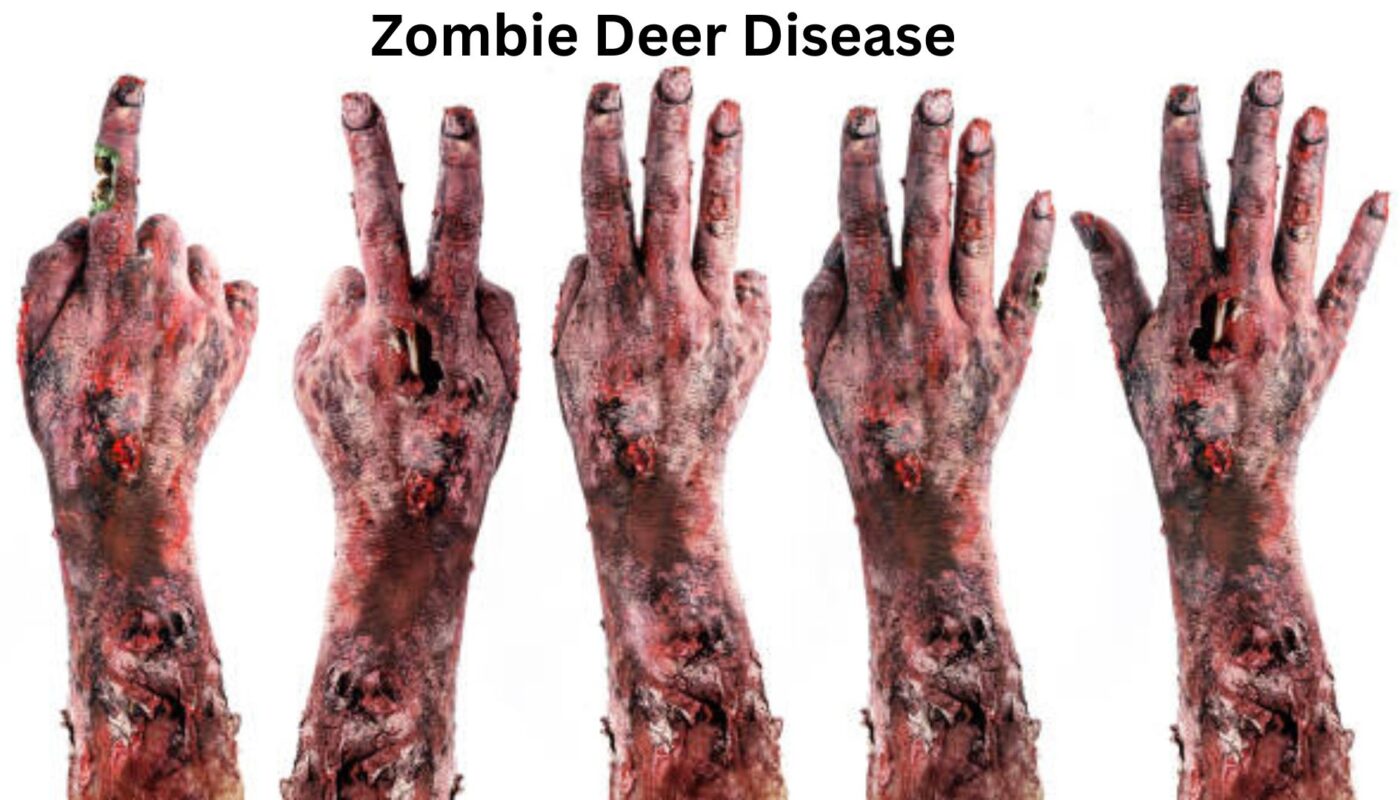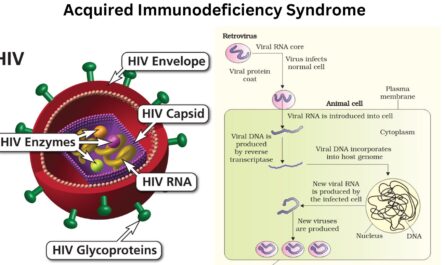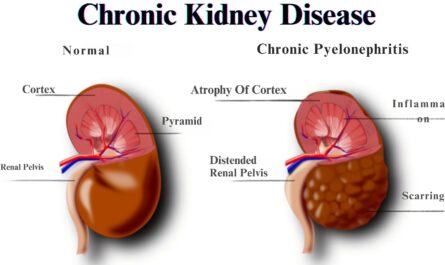Zombie Deer Disease
Understanding Chronic Wasting Disease (CWD)
Chronic Wasting Disease (CWD) is a neurodegenerative disorder that affects deer, elk, and moose, leading to severe symptoms and eventual death. Classified as a prion disease, it’s caused by the brain’s misfolding of normal prion proteins, resulting in progressive brain damage. First identified in the late 1960s in captive mule deer in Colorado, CWD has since been the subject of extensive research due to its fatal nature and mysterious origins.
The Spread and Impact on Deer Populations
CWD has been detected in wild and captive cervid populations in 26 states in the United States, Canada, South Korea, and Norway, signaling a widespread issue with significant implications for wildlife management and conservation efforts. The disease is highly contagious among deer populations, transmitted through bodily fluids and tissues, and even indirectly through environmental contamination. Infected deer often exhibit drastic weight loss, behavioral changes, and decreased interaction with other deer, eventually leading to death. The absence of a vaccine or cure for CWD poses a formidable challenge in managing its spread and safeguarding deer populations and ecosystems.
- Habitat loss due to urban development and agricultural expansion further threatens deer populations, leading to reduced food sources and increased mortality rates.
- Climate change contributes to the spread of diseases and parasites that affect deer and alter their natural habitats, impacting migration patterns and breeding cycles.
- Conservation efforts, including habitat restoration and management of hunting practices, are critical to stabilizing and increasing deer populations, ensuring their survival and ecological role.
Concerns About “Zombie” Characteristics
The term “Zombie Deer Disease” stems from the disturbing symptoms displayed by affected animals, such as emaciation, lack of fear of humans, and aggression, giving them a “zombie-like” appearance. These characteristics have heightened public concern and curiosity, though it’s crucial to approach the disease with scientific rigour and understanding. While capturing the public’s imagination, the zombification metaphor underscores the dire effects of CWD on wildlife and the urgency of addressing its spread.
Understanding Zombie Deer Disease
What is Zombie Deer Disease?
Zombie Deer Disease, more formally known as Chronic Wasting Disease (CWD), is a progressive, fatal neurodegenerative illness affecting deer, elk, reindeer, and moose. Characterized by dramatic weight loss (wasting), stumbling, listlessness, and other neurological symptoms, it has colloquially earned its nickname due to the zombie-like state it induces in afflicted animals. The disease belongs to a family of diseases known as transmissible spongiform encephalopathies (TSEs), which also includes Creutzfeldt-Jakob Disease (CJD) in humans and Bovine Spongiform Encephalopathy (BSE), commonly known as mad cow disease, in cattle.
Scientific Background and Origins
CWD is caused by prions, which are misfolded proteins that can induce normal brain proteins and misfold, leading to brain damage and the characteristic symptoms of the disease. First recognized in the late 1960s in captive mule deer in Colorado, CWD has since been detected in wild and captive cervid populations in 26 states in the U.S., as well as in two provinces in Canada, and several other countries around the world. Unlike viruses or bacteria, prions are remarkably resistant to environmental factors and standard disinfection methods, making the disease highly persistent in the environment once established.
Symptoms and Effects on Wildlife
Infected animals exhibit drastic changes in behavior and appearance, including excessive drooling, difficulty swallowing, lack of fear of people, aggression, and an inability to coordinate muscle movements. The disease is invariably fatal, with death occurring months to years after infection. There is no cure or vaccine available for CWD. The spread of CWD poses significant challenges to wildlife management and conservation efforts, threatening deer populations and the ecosystems they inhabit.
- Behavioral Changes: Due to pollutants or habitat changes, animals may exhibit unusual behaviors such as increased aggression, disorientation, or changes in feeding and mating habits.
- Physical Health Effects: Exposure to pollutants can lead to visible health issues such as skin lesions, tumors, and deformities in wildlife. Additionally, there might be reduced fertility and increased mortality rates.
- Ecosystem Imbalance: Affected wildlife can disrupt the food chain and ecosystem balance, leading to the overpopulation of some species and the decline or extinction of others.
- Genetic Damage: Pollutants and environmental stressors can cause genetic mutations and reduce genetic diversity within wildlife populations, potentially affecting future generations.
Zombie Deer Disease and Humans
The Potential for Cross-Species Transmission
Scientists and public health officials are concerned that CWD can cross the species barrier to humans, similar to how mad cow disease has in the past. Given the serious implications of such a jump, extensive research is ongoing to understand the potential risks. To date, there is no direct evidence that CWD has been transmitted to humans. However, laboratory studies have shown that the CWD prion can infect human prion proteins in a petri dish, suggesting a theoretical risk.
Current Research on Human Susceptibility
Research into humans’ susceptibility to CWD is ongoing. Studies involving non-human primates, such as monkeys, have produced mixed results. Some studies have shown that monkeys fed CWD-infected meat developed the disease, whereas others did not. These studies underline the complexity of predicting cross-species transmission risks and the need for caution and further research.
Precautions and the Importance of Monitoring
Given the uncertainties surrounding CWD’s potential impact on human health, several precautions are recommended for those in areas with known CWD infections. Hunters are advised to test deer for CWD before consumption, avoid eating meat from infected animals, and use protective gear when handling carcasses. Wildlife agencies and health departments continue to monitor the spread of CWD closely, both to manage the disease in animal populations and to safeguard human health. The importance of monitoring and research cannot be overstated, as understanding the dynamics of CWD transmission and its potential impact on humans will be crucial in formulating effective public health responses.
The Science Behind Chronic Wasting Disease CWD
What Causes CWD?
Chronic Wasting Disease is caused by prions, misfolded proteins that induce other normal proteins in the brain to misfold, accumulating in the brain tissue and causing cell death and tissue damage. Unlike viruses or bacteria, prions lack nucleic acids, making them unusually resistant to standard disinfection methods that would typically destroy pathogens. This resilience contributes to the challenges in controlling CWD.
Symptoms and Diagnosis in Wildlife
CWD-affected animals exhibit a range of symptoms, including drastic weight loss (wasting), stumbling, listlessness, and other neurological symptoms, leading to death. Diagnosis of CWD is primarily through post-mortem testing of brain, tonsils, or lymph node tissues for the presence of misfolded prions. Recent advancements have led to the development of more sensitive assays and even some live animal tests, though these are not yet widely implemented.
- Observation of Abnormal Behavior: Changes in normal activities, such as altered feeding habits, disorientation, or increased aggression, can indicate illness or injury.
- Physical Symptoms: Visible signs such as lesions, lumps, abnormal discharges, or changes in fur/feather condition can point to health issues.
- Weight Loss or Emaciation: Significant weight loss or a noticeable thinning of the animal can be a symptom of nutritional deficiencies or disease.
- Lab Tests and Imaging: Diagnosis often requires laboratory tests (e.g., blood tests) and imaging (e.g., X-rays) to confirm the presence of infections, diseases, or internal injuries.
Research on Disease Transmission and Evolution
CWD transmission is direct (animal-to-animal contact) and indirect (through contaminated environments). Research indicates that prions can bind to soil particles and remain infectious for years, complicating efforts to eradicate the disease from affected areas. Studies on the evolution of CWD focus on understanding how prions adapt and whether they could potentially cross species barriers. The concern is that similar to BSE (Mad Cow Disease) in cattle, which crossed into humans as Creutzfeldt-Jakob Disease (vCJD), CWD could pose a risk to human health. However, there is no documented case of CWD in humans, but research continues to monitor the disease closely, given the devastating effects of known prion diseases on mammals. Also, visit my other, Electronic Health Record (EHR) System.
Google and Public Awareness of Infectious Disease
How Google Facilitates Information Dissemination
As the world’s leading search engine, Google plays a pivotal role in disseminating information. Its algorithms are designed to prioritize relevant, authoritative content, making it an invaluable resource for the public seeking information on health-related issues, including “Zombie Deer Disease.” By indexing vast amounts of data from credible sources, Google ensures that users can access the latest research, news, and guidelines from health organizations and wildlife agencies. Moreover, Google’s news aggregation and alerts can keep users informed about recent developments, while its support for various content types (articles, videos, podcasts) caters to diverse learning preferences.
The Role of Search Engines in Public Health Awareness
Search engines like Google significantly contribute to public health awareness by bridging the gap between complex scientific information and the general public. They curate content to simplify the understanding of diseases and their impact, encouraging preventive measures. During health crises, Google often collaborates with health organizations to provide direct access to accurate, up-to-date information through special banners or dedicated sections. This accessibility helps in debunking myths and spreading awareness about diseases like Zombie Deer Disease, guiding the public on how to react responsibly.
Popular Google Queries About Zombie Deer Disease
Common queries about Zombie Deer Disease reflect public concern and curiosity about the disease’s nature, risks, and impact. Some of the most searched questions include:
- What is Zombie Deer Disease?
- Can humans get Zombie Deer Disease?
- How does Zombie Deer Disease spread?
- Symptoms of Zombie Deer Disease in deer
- Is there a cure or vaccine for Zombie Deer Disease?
These queries highlight the need for ongoing education and information dissemination to address public concerns and misconceptions.

Preventing the Prion disease spread to humans
Strategies Employed by Wildlife Agencies
Wildlife agencies across affected regions employ various strategies to manage and prevent the spread of Zombie Deer Disease. These strategies include monitoring and surveillance programs to track the spread of the disease, managing deer populations to reduce density and minimize transmission, and implementing regulations on the transport and disposal of deer carcasses. Some regions also enforce hunting restrictions in areas with high infection rates to control the spread among wild deer populations.
The Role of Hunters and the General Public in Prevention
Hunters play a crucial role in preventing and managing Zombie Deer Disease. By following guidelines set by wildlife agencies, such as submitting samples for testing, avoiding transporting carcasses from affected areas, and practicing safe handling and processing of deer meat, hunters can help minimize the risk of spread. The general public, particularly those living in or near affected areas, can contribute by staying informed, supporting wildlife management efforts, and reporting sick or dead deer to local authorities.
Future Research Directions and Funding
Future research on Zombie Deer Disease is vital to understanding its transmission mechanisms and potential impacts on human health and developing effective management and prevention strategies. This includes studying genetic factors that may influence susceptibility or resistance to the disease and exploring vaccine development for wildlife. Increased funding for wildlife health research is essential to support these efforts, requiring collaboration between governmental bodies, non-profit organizations, and the scientific community to allocate resources effectively and prioritize research that can lead to practical solutions.
Zombie Deer Disease Spread in the Media
Coverage and Its Impact on Public Perception
The media’s coverage of “Zombie Deer Disease,” formally known as Chronic Wasting Disease (CWD), has played a pivotal role in shaping public perception of the disease. With headlines often emphasizing the “zombie” aspect, there has been a significant increase in public interest and concern. This coverage has been instrumental in raising awareness about the disease’s presence in wild deer, elk, and moose populations across North America and in some parts of the world. However, the sensationalist tone in some reports has also contributed to misconceptions and unnecessary panic among the public.
The Balance Between Awareness and Unnecessary Panic
Striking the right balance in media reporting is crucial. Awareness is essential for prevention and control, yet it mustn’t escalate into panic. Educating the public about the disease, its transmission, and the ongoing efforts to contain it without causing undue alarm requires careful wording and a focus on facts. Media outlets are responsible for providing information that empowers the public to take appropriate precautions, particularly hunters and those living in affected areas, without contributing to fearmongering.
Critiques and Commendations of Media Approaches
Critiques of Zombie Deer Disease’s media coverage often center on sensationalism and a lack of context regarding the actual risk to humans. Highlighting the disease’s nickname without explaining the scientific efforts to understand and contain the disease can mislead the public. On the other hand, commendable media efforts include thorough investigative reporting, interviews with scientists and wildlife experts, and features on the research aimed at finding a cure or vaccine for CWD. Such balanced reporting educates the public and encourages informed discussion about wildlife conservation and disease prevention.
Global Implications
Similar Diseases in Other Parts of the World
Chronic Wasting Disease shares similarities with other prion diseases around the globe, such as Bovine Spongiform Encephalopathy (BSE) in cattle, also known as “Mad Cow Disease,” and Creutzfeldt-Jakob Disease (CJD) in humans. These diseases underscore the importance of monitoring and managing animal populations to prevent cross-species transmission. The global presence of prion diseases highlights the interconnectedness of ecosystems and the need for international cooperation in disease management and research.
International Cooperation in Monitoring and Prevention
The spread of CWD and similar diseases has prompted international cooperation in monitoring wildlife health and preventing disease spread. Organizations such as the World Health Organization (WHO) and the World Organisation for Animal Health (OIE) play key roles in setting disease surveillance and control guidelines. Efforts include sharing research, standardizing diagnostic tests, and implementing best practices for wildlife management and hunting. Such cooperation is essential in addressing diseases that do not respect national borders.
Lessons Learned from Global Outbreaks of Related Diseases
Global outbreaks of prion diseases and other wildlife diseases have taught valuable lessons in early detection, rapid response, and the importance of public education. For example, the BSE outbreak in the UK led to stricter regulations on animal feed and food safety standards worldwide. These incidents underscore the necessity of continuous vigilance, investment in disease research, and the need for a coordinated global response to emerging wildlife diseases. By applying these lessons, governments, scientists, and the public can better navigate the challenges posed by diseases like Zombie Deer Disease, minimizing their impact on wildlife, domestic animals, and potentially humans.
FAQ: Zombie Deer Disease
What is Zombie Deer Disease?
Zombie Deer Disease, scientifically known as Chronic Wasting Disease (CWD), is a fatal, neurological illness that affects deer, elk, and moose. It’s caused by prions, which are misfolded proteins that lead to brain damage and symptoms such as weight loss, lack of coordination, and aggressive behavior, hence the “zombie” nickname.
2. Can humans get Zombie Deer Disease?
As of the latest research, there is no evidence that CWD can be transmitted to humans. Studies are ongoing to ensure the disease does not pose a risk to human health, especially to those who consume infected venison.
3. How is Zombie Deer Disease spread among wildlife?
CWD spreads through direct contact between animals and the environment. Prions can remain infectious in soil and water for years, posing a risk to animals that ingest contaminated materials.
4. What are the signs of Zombie Deer Disease in animals?
Infected animals may show drastic weight loss, stumbling, lack of coordination, listlessness, drooling, excessive thirst or urination, drooping ears, and lack of fear of humans.
5. Is there a cure or vaccine for Zombie Deer Disease?
Currently, there is no cure or vaccine for CWD. Wildlife management strategies focus on preventing the disease’s spread through population monitoring, controlled hunts, and restrictions on the movement of potentially infected animals or carcasses.
Conclusion
Zombie Deer Disease, or Chronic Wasting Disease (CWD), is a significant concern for wildlife conservation and potential human health risks. No cases in humans have been documented yet. Ongoing research, public education, and international cooperation are important for monitoring and managing the disease’s impact on deer, elk, and moose populations. Balanced reporting and informed discussions are crucial for understanding the disease, preventing its spread, and ensuring the safety of wildlife and humans. Lessons learned from dealing with CWD will aid in combating this disease and future wildlife outbreaks more effectively.




One thought on “Zombie Deer Disease in Human | What Causes CWD?”